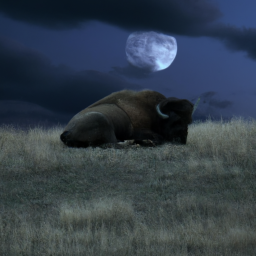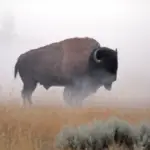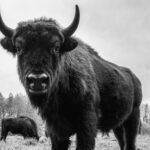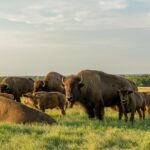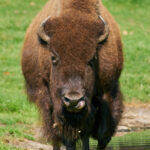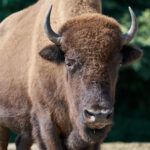Bison Social Structure
Bison are social animals, living in herds that can range in size from a few dozen to several hundred individuals. Within these herds, there is a clear hierarchical structure, with dominant males or “bulls” leading the group. The females, or “cows,” and their offspring generally follow the lead of the dominant males. This social structure plays a crucial role in their sleeping patterns and choice of sleeping locations.
Bison Sleeping Patterns
Bison are diurnal animals, meaning they are primarily active during the day and sleep at night. However, their sleep patterns can be influenced by various factors, including the availability of food, water, and the presence of predators. Bison usually sleep for shorter durations throughout the night, interspersed with periods of wakefulness.
Factors Influencing Bison Activities
Several factors influence Bison activities, including their sleeping patterns. These factors include their need for food, water, and safety. Bison are herbivores and require large quantities of grasses and other vegetation to sustain themselves. They are highly selective in choosing habitats that provide ample food sources, which in turn has an impact on their sleeping locations.
Bison Habitats and Sleeping Locations
To understand where bison sleep, it is necessary to examine their preferred habitats and specific sleeping locations within these habitats.
Typical Bison Habitats
Bison are adaptable animals and thrive in a variety of habitats. They can be found in grasslands, savannas, meadows, and even forests. These habitats provide them with the necessary resources such as food, water, and shelter. Bison are known to form seasonal migrations in search of favorable grazing areas and to cope with changing environmental conditions.
Preferred Sleeping Areas within Habitats
Within their habitats, bison have specific preferences for their sleeping locations. These areas are often chosen based on safety, proximity to food and water, and the terrain of the surrounding landscape. Bison have a keen sense of their surroundings and are careful when selecting their sleeping sites.
Influence of Season on Sleeping Locations
The season also plays a significant role in determining where bison choose to sleep. During warmer months, they tend to seek out shady areas or areas with access to water to cool down. In contrast, during colder months, they may prefer sheltered spots or locations with natural windbreaks to protect themselves from harsh weather conditions.
Temperature and Bison Sleep
Temperature is a crucial factor that affects bison sleep patterns. Bison have developed adaptations to cope with both heat and cold, which enables them to find suitable sleeping locations based on prevailing weather conditions.
Bison and Heat: Summer Sleeping Patterns
During hot summer months, bison may exhibit different sleeping patterns compared to other seasons. They may sleep for shorter durations during the cooler hours of the day and remain more active during the early morning and late evening when temperatures are milder. This behavior allows them to avoid excessive heat and conserve energy in the heat of the day.
Bison and Cold: Winter Sleeping Habits
In contrast, bison have a remarkable ability to withstand extreme cold temperatures during winter months. They have a dense and insulating layer of fur, which helps them retain body heat. During this time, bison may seek out sheltered areas or form tight groups to provide warmth and protection from the cold.
Bison Adaptation to Temperature Changes
The ability of bison to adapt to both hot and cold temperatures is a testament to their resilience as a species. Their physiological and behavioral adaptations allow them to survive in a wide range of climates and find suitable sleeping locations to ensure their well-being.
How Bison Choose Their Sleeping Sites
The selection of appropriate sleeping sites is critical for bison to rest and rejuvenate. They consider various factors when choosing their sleeping locations, including safety, proximity to food and water, and their preferences for certain terrains.
Safety Factors
Safety is of utmost importance to bison, particularly during sleep when they are most vulnerable to predation. Bison tend to choose sleeping sites that provide good visibility and offer natural barriers or elevated vantage points to detect potential threats. They also prefer areas with minimal vegetation that would impede their line of sight.
Proximity to Food and Water
Bison are herbivores, and the availability of food and water greatly influences their choice of sleeping locations. They prefer areas close to reliable food sources, such as grasslands or meadows with ample grazing opportunities. Similarly, access to water sources, such as rivers or watering holes, is essential for their survival and contributes to their choice of sleeping sites.
Preferences for Certain Terrains
Bison also exhibit preferences for specific terrains when selecting their sleeping sites. They often choose flat or gently sloping areas that offer stability and comfort during sleep. Additionally, bison tend to avoid areas prone to flooding or muddy conditions as they can impede their ability to rest peacefully.
Physical Characteristics of Bison
To better understand bison sleeping patterns, it is essential to explore their physical characteristics, as these inform their adaptations for open-air sleeping.
Size and Strength of Bison
Bison are among the largest land mammals in North America, with adult males weighing up to 2,000 pounds. Their size and strength provide them with a competitive advantage in their habitats and contribute to their safety during sleep. Larger individuals can deter potential predators and protect the herd while resting.
Adaptations Allowing for Open-Air Sleeping
Bison have evolved specific adaptations that allow them to sleep in open-air environments. Their robust bodies and powerful muscles enable them to lie down and rise easily, even on uneven terrain. Additionally, their elongated legs and well-developed sense of balance allow them to maintain stability while sleeping.
Bison Fur and Insulation During Sleep
Another crucial adaptation of bison is their thick fur, which provides insulation during sleep. This dense coat helps regulate body temperature, keeping them warm during cold weather and protecting them from excessive heat during warmer months. The fur serves as a natural insulation blanket, enabling bison to sleep comfortably despite varying environmental conditions.
Importance of Group Dynamics in Bison Sleep
Bison are highly social animals, and their group dynamics play a crucial role in their sleeping patterns and overall well-being.
Group Protection During Sleep
One of the key advantages of bison living in herds is the increased protection they provide to each other. When it comes to sleep, the presence of other herd members enhances safety by increasing vigilance and deterring predators. Bison often form a protective circle or semi-circle formation when resting, with adults positioned on the outer perimeter to keep a watchful eye on potential threats.
Hierarchy and Sleeping Position
Within the herd, a hierarchy exists, with dominant males occupying higher positions. This hierarchy also influences the sleeping positions of individual bison. Dominant bulls often choose prime sleeping spots, followed by cows and their calves. This hierarchy ensures optimal protection for the herd during sleep and reflects the social structure of bison.
Dual Role of Male Bison During Sleep
Male bison, or bulls, play a dual role in the protection of the herd during sleep. Apart from their hierarchical positioning, they also act as sentinels, scanning the surroundings for any signs of danger while the rest of the herd sleeps. This sentinel behavior helps maximize the safety of the entire group and contributes to the overall well-being of bison populations.
Bison Sleep Posture and Position
The posture and position in which bison sleep provide fascinating insights into their behavior and adaptations to their environment.
How Bison Lay Down for Sleep
Bison primarily sleep by lying down, but the process of lying down is not as simple as it may seem. Due to their large size, bison take a deliberate and careful approach to lie down. They often kneel on their front legs and then tuck their hind legs underneath before lowering their bodies fully to the ground. This method allows them to lie down with control and minimize potential injuries.
Sleeping Postures and Their Significance
Bison exhibit different sleeping postures, depending on the circumstances and their level of comfort. The most common posture is lying on one side, either with their legs tucked underneath their bodies or slightly extended. This position maximizes body contact with the ground, allowing for better thermoregulation and muscle relaxation during sleep.
Cases of Bison Sleeping While Standing
Although bison primarily sleep while lying down, there have been instances where they sleep while standing. This behavior is most commonly observed in situations where the herd needs to remain vigilant while resting, such as when there is a potential threat nearby. Bison are capable of entering a light sleep while standing, with their heads often lowered towards the ground, ready to respond to any signs of danger.
Bison Sleep Cycle and Duration
Understanding the sleep cycle and duration of bison provides valuable insights into their overall behavioral patterns and their need for rest.
Typical Sleep Time for Bison
Bison, like many diurnal animals, primarily sleep during the night. However, their sleep patterns are governed by various factors and can differ significantly based on environmental conditions and the specific needs of the herd. On average, bison sleep for approximately four to six hours each day, but this can vary depending on the availability of resources and the presence of potential threats.
Factors Influencing Sleep Duration
Several factors influence the duration of sleep for bison. These factors include the age of the individuals, the current physiological state (breeding season or calving season), and prevailing environmental conditions. Bison in good health and well-established social groups tend to have more consistent sleep patterns and durations.
Difference in Sleep Patterns of Young and Adult Bison
Young bison, known as calves, require more sleep compared to adult bison. Calves need additional rest for growth and development, often sleeping for extended periods during the day. As they mature, their sleep patterns gradually align with those of the adult members of the herd, with a reduced need for sleep during the daytime.
Impact of Predators on Bison Sleep
Predators play a significant role in shaping the behavior and sleep patterns of bison. Understanding the interaction between bison and predators provides insights into their choice of sleeping locations and their ability to respond effectively to potential threats.
Common Predators of Bison
Bison have historically faced predation from large carnivores such as wolves, bears, and mountain lions. These predators pose a threat to bison, particularly during vulnerable moments like sleep. The presence of predators influences bison behavior and the precautions they take while selecting sleeping sites.
Defense Mechanisms During Sleep
Bison have developed various defense mechanisms to protect themselves from predation, even while sleeping. Their sheer size, strength, and defensive behavior, such as forming protective circles, can help deter predators and decrease the risk of an attack. The vigilant behavior of sentinel bulls also contributes to the overall safety of the herd during sleep.
Observable Effect of Predator Presence on Sleep Pattern
The presence of predators has a significant impact on bison sleep patterns. Bison are naturally attuned to sensing potential threats and may sleep for shorter durations or exhibit more vigilant behavior when they sense the presence of predators nearby. These adaptations allow bison to minimize the risk of predation and ensure the safety of the herd during sleep.
Does the Decrease in Bison Population Affect Their Sleeping Habits?
The declining trend in the american bison population count in the us might indeed impact their sleeping habits. With fewer bison roaming the rugged plains, they may feel a heightened sense of vulnerability and alter their sleep patterns accordingly. Adapting to the changing landscape, bison could potentially modify their sleeping behaviors for enhanced safety and survival in the face of dwindling numbers.
Human Interaction and Impact on Bison Sleep
Human activity and interaction can have a profound influence on the sleep patterns and well-being of bison populations. Understanding these impacts is crucial for effective conservation and management efforts.
Impact of Hunting on Bison Sleep
Historically, hunting played a significant role in reducing bison populations. The constant threat of human hunting impacted bison behavior, causing them to be more cautious and vigilant during sleep. Although hunting practices have been regulated in modern times, the fear and avoidance of humans may still influence their sleep patterns, particularly in areas with high human activity.
Effects of Encroachment into Bison Habitats
As human populations expand and encroach into bison habitats, it can lead to disruptions in their sleep patterns. Noise pollution, increased human presence, and habitat fragmentation can all contribute to disturbed sleep in bison. These disruptions can have long-lasting effects, potentially impacting their overall health and well-being.
Bison in Captivity: Sleep in Zoos Vs Wild
Bison in captivity, such as those in zoos or wildlife reserves, may exhibit different sleep patterns compared to their wild counterparts. While efforts are made to recreate natural conditions in captivity, factors such as limited space and altered social structures can impact their sleep. Adapting to the artificial environment and adjusting to new social dynamics may influence the sleeping habits of captive bison.
In conclusion, understanding bison behavior and sleeping patterns requires exploration of their social structure, habitats, physical characteristics, and interaction with the environment. Bison select sleeping locations based on factors such as safety, availability of resources, and their preferences for certain terrains. Temperature plays a significant role in their sleep patterns, with adaptations allowing them to cope with both heat and cold. Group dynamics, predator presence, and human interactions also impact their sleep. By expanding our knowledge of these fascinating creatures, we can better appreciate their unique behaviors and contribute to their conservation and well-being.

